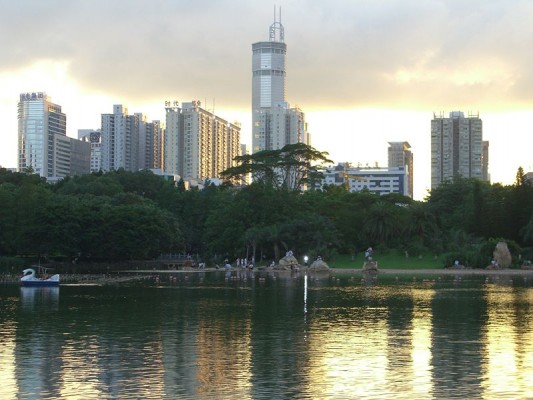 Every Gizmodian’s home is filled with gadgets, and most of those products are manufactured in China. But what is it actually like to manufacture technology in China? As part of our Year of the Rabbit celebrations, we speak to Australian entrepreneur, Ruslan Kogan, about his experiences in creating a technology company through partnerships with Chinese manufacturers.
Every Gizmodian’s home is filled with gadgets, and most of those products are manufactured in China. But what is it actually like to manufacture technology in China? As part of our Year of the Rabbit celebrations, we speak to Australian entrepreneur, Ruslan Kogan, about his experiences in creating a technology company through partnerships with Chinese manufacturers.
Image: Shenzhen, China Wikimedia Commons
It was only in 2006 when a younger Ruslan Kogan decided to try his luck as a consumer electronics mogul. His first shipment of televisions, to be manufactured in China, was a battle in negotiation and a key example of what it’s like to create products in the land of dragons and emperors.
“When I went to first start Kogan, I didn’t have any money, so the container I was ordering was one small container of TVs. I negotiated with the factory and we reached a good price and good terms and good quality, but when I then broke the news to them that the container of TVs I wanted was just one container, they didn’t want to talk to me anymore.
“So they said to me, ‘Nah, no, sorry, not interested. We work on a mass scale, we can’t make profit off of one container’. So I had to find a way to add value to them, and what I did was stayed up one night and redid all their marketing material. And when I was done I emailed it to them and told them ‘The value in dealing with me isn’t the profit you make from one container, I can add value in other areas and I really want to work with you.
“They replied nearly immediately saying thankyou and accepted the order. Then about a week later they emailed me and said that because of what I helped them with, they won a massive customer in America.”
Kogan tells that tale to emphasise a key point: relationships are key for Chinese businessmen. It’s not exclusively about making money, where every decision is made on the best possible profit margin, but about forming an ongoing relationship with clients to create a better overall business.
But it’s not all smooth sailing. Dealing with the Chinese manufacturers can be tricky, most notably due to the language and cultural barriers between Australians and Chinese. In the five years since his first TV shipment, Kogan has learnt a lot of lessons about dealing with the walls between cultures.
“The number one thing you have to ensure is that you have to communicate effectively. And what that means is that we’ll sometimes have conference calls with them, but their English isn’t the greatest so we’ll always follow up in an email outlining the agreements made. You want to document everything in writing – it’s how you overcome the language barrier, because everyone can use Google translate.”
Yet from the difficulties that arise from cultural difficulties also comes benefits from a business perspective. And it comes in the cultural need to “keep face”
“One of the things they all care about and never want to do is ‘lose face’. That makes doing business with them very easy because if you document everything and then ask ‘do we have an understanding on this?’ and then later down the track something doesn’t go as planned, you can confront them with the emails and they’re always very quick to act on it. They’re very honest and they don’t want to lose face, so they will do their absolute best to keep everyone happy and to keep the relationship up.”
But what about the actual manufacturing process? With the vast majority of consumer electronics all carrying a “Made In China” sticker somewhere on the packaging, it’s easy to imagine a country packed with factories lined up like dominoes. Kogan explains that Shenzhen is the hub for his manufacturing needs.
“There used be factories in Shenzhen, but it’s become this massive business centre, so all the factories are about an hours drive away, and they keep the head office in Shenzhen. And some of these factories are absolutely massive – like they have whole cities which are pretty much one factory. And some of the factories we deal with have close to one million employees.
Considering the size, you’d expect these factories to be well kitted out. According to Kogan, they definitely are.
“They’ve got these huge R&D centres, they’ve got all these facilities for testing in all different environments – like our TVs will go through testing in 0 degree weather to rooms that are 55 degrees. They’ve got all these really controlled environments and it’s all very, very advanced.”
How advanced? After a trip to the Ferrari factory in Italy, Kogan considers China on par with the reputable auto-maker, which is high kudos indeed.
China is the current hub of electronics manufacturing for most consumer electronics these days, but that won’t always be the case, in Kogan’s view.
“It all works in cycles. It’s whatever country’s economically performing the best at the time and has the money to invest in these sorts of facilities. Even if you look at the last 50 years at one stage it was Germany then it was Japan then it was the USA and now it’s China. So it’s very likely another country will become the manufacturing hub for electronics.”
But until that day comes, we can continue to enjoy the benefits of China’s impressive and wide ranging skills in manufacturing electronics.